Years later, still helping birds
Cedar Key Seabird Rescue was founded in August 2016 by the Cedar Keys Audubon with support from several organizations, including the UF/IFAS Nature Coast Biological Station, Florida Sea Grant, Florida Fish and Wildlife Conservation Commission (FWC), and Audubon Florida. This group of intrepid volunteers formed in response to the high number of bird entanglements in Cedar Key, an area identified as a bird entanglement hotspot by FWC and a regional UF survey. While volunteers respond to all kinds of injured birds, the focus of the program is to address seabird entanglement and injury caused by interactions with fishing tackle and fish carcasses.
In 2019, seabird rescue volunteers responded to 57 calls regarding more than 24 species of birds. The top three bird types were seabirds: brown pelicans, cormorants, and gulls. The leading type of injury was entanglement in fishing line, with 20 such cases in 2019. The majority of birds rescued (22) were taken to a rehabilitation facility, either in Homosassa or Gainesville. The next most common outcome was for the bird to be immediately released after receiving rescue assistance (12). Overall, the rescue efforts resulted in 18 confirmed successful releases. In 2019, there was at least a 32% success rate for rescues, which is about the level we expect based on previous years. The summary tables below detail information summarized from rescue reports received in 2019.
Making progress
Since formation of the rescue group, there is evidence that bird entanglement incidents are declining locally. This could be due to several factors but is likely at least in part due to the signage and other educational efforts that are part of Cedar Key Seabird Rescue. In Aug-Dec 2016, there were 21 rescue events and 38% of these calls were for entangled pelicans. Over the same period in 2017, the program also received 21 calls but only 28% of them related to an entangled pelican. Comparing 2017-2019 data, there were 49 reports of entangled birds in 2017 but only 16 such reports in 2018 and only 14 entangled pelican reports in 2019. This represents a 71% decline in reports of pelican entanglements in the Cedar Key community from 2017 to 2019. We hope that over time the downward trend in pelican entanglements continues.
Volunteers in action
Since 2016, volunteers have contributed 730 hours and driven over 12,000 miles all in the name of rescuing local birds. The volunteers are called upon by tourists, pier anglers, residents, and even the City of Cedar Key police department. The Cedar Key Seabird Rescue initiative is an important part of sustainable fishing in Cedar Key. Check out the gallery below of our wonderful volunteers in action!
 0
0
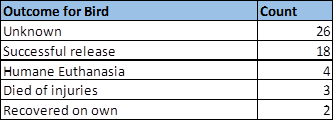

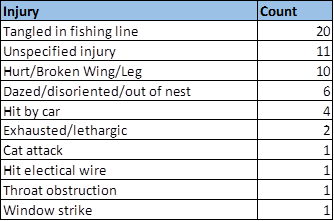
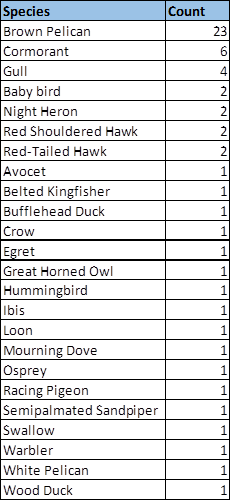
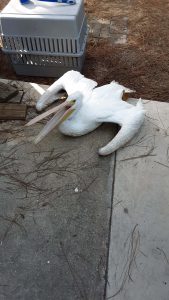

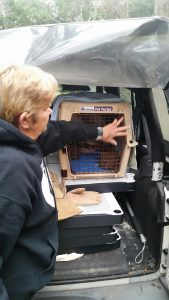
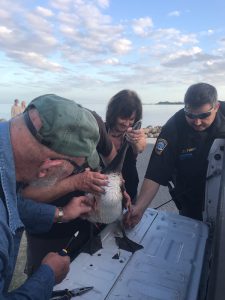

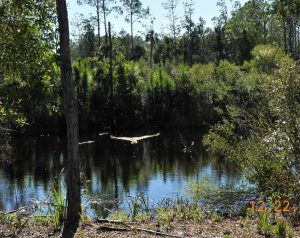
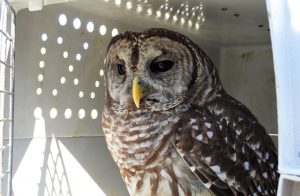
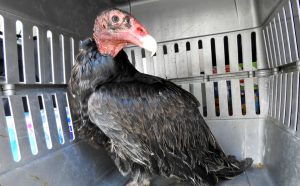
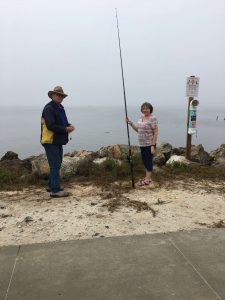

Comments:
February 16, 2022
Joanne and I loved Capt Dan and with him we caught many personal record fish on many occasions We shared Nature Coast ecology with him for many years We always had Dan fish with us We both are devastated by the loss of his friendship and knowledge Joe and Joanne
December 9, 2021
Awesome post!
August 27, 2021
Excellent Work Savanna! I would like to speak with you about your mapping effort; if you have a few moments, let's setup a quick call or virtual meeting...let me know what you're availability is...THANKS! Best regards, Tom
August 20, 2021
I think this is a real great blog post. Much obliged.
August 18, 2021
Hey, Samuel. Thanks for your insight. Though this post focuses on my lab experiments, I also conducted a trap study off of Cedar Key similar to what you did with your blue crabs. I collected data on the number of crabs per trap to see if we could observe cannibalism. Looking forward to reporting back with another post once I process that information!
August 16, 2021
I set crab traps on the south shore of East Bay, east of Gulf Breeze, I have a holding pen for the catch and I'm harvesting only blue claw crabs. Left in the pen without an adequate food supply, the crabs are cannibalistic. I would imagine that stone crabs in traps with a long soak time, might exhibit the same behavior.
August 16, 2021
Nice summary of your work at Suwannee River WMD this summer. Thanks for your help Alex!
August 10, 2021
I think this is a real great blog article.Thanks Again. Will read on
April 5, 2021
Hi Ana - We do not presently have a volunteer program with NCAP but as we get established we hope that will develop over time. In the meantime, you can explore the UF Water Watch programs and LAKEWATCH programs which both operate volunteer water quality monitoring in the area.
April 4, 2021
Do you have a volunteer program? I live in the area and would love to contribute to my community and the NACP.
March 31, 2021
The recipe directions can be downloaded as pdf (link here and in post)
March 30, 2021
could you give directions
March 24, 2021
Also, I added a link to Water Watch near the end to direct folks to other programs.
March 24, 2021
Thank you for the comment and for your efforts with Water Watch. I also coordinate volunteers with Water Watch, it's a great program. All UF partners in the region have already been informed of the project. Apologies for any confusion, the water quality monitoring project outlined in this post is different from Water Watch in that we are collecting a different set of parameters and our data has to meet QA standards set forth by DEP in order to be used in management decision-making. I referenced the historical water quality program in the original post, but did not go into detail. This program is actually getting a much longer-standing one back up and running. Tom Frazer's lab used to run the same program from 1998 to 2019 but the program (called Project COAST) lapsed due to loss of funding and staff turnover. I hope this clarifies and that you will continue to collect samples with Water Watch. The more data, the better!
March 24, 2021
This blog is incorrect about the "commencement" of water sampling. I am a volunteer with Florida Sea Grant and have been taking water samples for them for a few years. Why have we not been informed about this?Maybe you should check with the UF people.
March 24, 2021
This blog is incorrect regarding the "commencement" of water sampling. I am a volunteer with Florida Sea Grant and have been taking water samples for the past few years. Why have we not been informed about this new "project"? Maybe you should talk to the UF folks in area.
February 22, 2021
Hi Karl - Sorry but at this time we do not have any submerged grasses available. Also please do not plant water hyacinth or hydrilla because these are invasive plants not native to FL!
February 21, 2021
Can we get river grass to plant? EEL Grass is it available? turtle grass, manatee grass, shoal grass, mangrove leaves, various algae, water hyacinth, acorns, and hydrilla etc........ Thanks Savannah
January 25, 2021
Jan 25,2021 to whom it may concern, I’m at Cedar key boat launch watching a pelican in distress with a fish in his throat.. I was trying to find help for him. Please keep checking this area for distressed birds! This is the second one I’ve seen Thankyou
October 21, 2020
Hi Savanna! My husband John Crissman and I have helped you with the shoreline replanting on airport key (name?!). We live at Old Fenimore Mills and are wondering: if we got the volunteers & funding needed could you help us implement a shoreline solution here? !!
October 5, 2020
Thanks for sharing your docks building ideas with us. It is useful information for docks services.
August 30, 2020
Thank you for the info! Rhonda
August 30, 2020
Hi Rhonda, We are experimenting with different monitoring methods. In the first pilot test, we just did mass change measurements and visual surveys of percent cover on the outside. But with these we are trying some 3D surface modelling as well as quadrat methods. The monitoring technique is definitely something we are still working on. But we do not plan to remove any of the units like you suggest is common for shell bags. Open to ideas if you have any!
August 28, 2020
Savanna, the JR-CSA prisms look very promising. How do you monitor/measure the recruitment/settlement on the oyster prisms? Typically with bags, you remove a sample bag. Do you just observe the outside of the prism?
August 20, 2020
Thanks for the suggestion!
August 19, 2020
This is great news! You all do so we'll reaching out to the public for help. I don't know if it's allowed but for those who don't follow your page it may be beneficial to post this info on Levy county Word of Mouth FB page. I think you you all you gain a lot of followers and hopefully volunteers!
August 19, 2020
Congratulations my friends
August 19, 2020
Hi Chris - It varies by project but if you don't take into account the planning and permitting, these projects ranged from 1 day to a few weeks to deploy. Building the materials is also a key part, and that also varies from days to weeks. Honestly, the planning and the permitting is the slowest step but it's very rewarding when you get to deployment day!
August 19, 2020
Excellent, informative story! I had only been familiar with shell bags, so thanks for the lesson in reef building! How long did each of these projects take? It looks to me like it's labor intensive.
August 18, 2020
Hi Donna - absolutely! We can sign for community service hours. The 2020 event registration is open here: https://www.eventbrite.com/e/contactless-coastal-cleanup-cedar-key-tickets-116878588003
August 17, 2020
Will you do this again? I have a son in 10th grade that would like to participate. Could he get someone to sign off on his community service hours if he participated?
June 13, 2020
Nice job guys! Keep up the good environmental work.
June 9, 2020
Thank you so much, Nikki! Hoping for a better season this year, let us know how it goes :)
June 9, 2020
Hi there, Great article! I did not know that there was a way to report your catch so this was new to me - thanks! I also signed the pledge:) We scallop all season on the west coast and last year was great the first weekend then it was a total bust. Nikki
June 9, 2020
Hi there! We assisted the City of Cedar Key in hosting the Lighting of the Cedar Key Light Station on Seahorse Key in 2019. This event is usually the week of July 4th, but since many City events have been canceled for the near future we are unsure if this particular event will still happen this year. Please keep an eye on our website and social media pages, as well as the Cedar Key Chamber of Commerce pages for any updates!
June 2, 2020
I live in St. Pete. I visited Cedar Key for a week a few yrs back and am again going there for 'laid-back-quiet ' i have been told there is some kinda' ceremony?,festival? Bi yearly event ? where the UF students ? and visotors go out to Seahorse Key and do something? And turn on the lighthouse light! I would be totally interested in being there for whatever
May 5, 2020
Modification of natural hydrology is definitely a leading cause of oyster loss - as you say it can go both ways, making water either too fresh, too salty, or too variable for oysters to do well. Hopefully, restoration projects can mitigate this, or at least practitioners should take hydrological conditions into account this fact when they begin an effort. Unfortunately, this also means that many areas where oysters have been lost are no longer suitable for them to return.
May 5, 2020
The biggest thing is the alteration of the fresh water flow. They dug ditches and drain the swamp. When it rains it gets fresh and then it goes back to to salty.
April 17, 2020
Thanks, Tom! We have been talking about ways to add mangroves here, perhaps using burlap bags to form amorphous planters. We will check out the resources you shared and also make another blog post if we are ever able to try it and have success. If you are aware of anyone who has added mangroves to limerock without the benefit of the planter trough, let me know!
April 17, 2020
Great story and important lesson on options to improve the ecological health of a stark vertical seawall! There are other examples of functioning seawall enhancement efforts, which also include a vegetative component that are now functioning in various locations in both the Tampa and Sarasota Bay area. Ulele Spring in downtown Tampa has an enhanced seawall feature which consists of limestone rock placed in front of a seawall that also includes a planting trough; this sediment tube facilitates the growth of mangroves trees. Four years later, these red mangrove trees are 7 feet tall!. These particular trees can be trimmed to preserve the viewshed, while still providing great habitat for both fish and avifaunal species, in addition to the crustaceans within the rock crevices. Please visit: www.ecosphererestorationinstitute.org for more information on this site.
March 16, 2020
I like that fishing can be a stress reliever. So many people, including myself, get so stressed out in their daily lives. It would be great for everyone to find a hobby, like fishing, to take their minds off the troubles of their everyday life in order to just enjoy themselves and to relieve stress. It just seems like it would be better for everyone to stress less and become more calmed and relaxed! That way everyone can enjoy their life more.
February 27, 2020
Hi Jim - Thanks for your comments and your efforts to protect dunes! Dune restoration is a really important strategy for both wildlife conservation and shoreline protection. I am not as well-versed on dune issues as I am with marsh and oyster, but I do know that many of our dunes in FL are smaller than they used to be, even after restoration. This is largely related to the high costs of restoration. But every bit we can do to restore and enhance dune elevation and stabilization with beneficial plants like sea oats is a step in the right direction. Dunes take the brunt of coastal storms and they often require restoration after storms. If you are interested in more, check out this really great resource on dune restoration: http://edis.ifas.ufl.edu/pdffiles/SG/SG15600.pdf
February 27, 2020
I appreciate your focus on the importance of natural resources to protect our shoreline.. We have a place SeaGrove on the beach..Over the years I have watched the county try a number of things to protect the dunes, including dredging off shore, with little success..I plant sea oats ( grass ) and use sea weed to establish a sound environment for birds and protect the dunes during major storms...While I am proud of what we have achieved over many years, I appreciate it will not be sufficient to totally protect the dunes in a major storm Any other suggestions would be appreciated...
February 19, 2020
Hi Daniel - I emailed you the info but you can register for the workshop coming up this Friday at this link: https://www.eventbrite.com/e/2020-cedar-key-seabird-rescue-workshop-tickets-91151166593
February 19, 2020
I would like to assist with bird rescue. Please advise when and where there will be training.
December 18, 2019
Great report. Thanks for the update, looks like things are progressing nicely.
October 28, 2019
Thank you so much, Denise! We are happy to have you here, too :)
October 26, 2019
So fortunate to live along this shoreline and know that UF and partner agencies are working to protect it.
October 25, 2019
Thanks, Jim! Great seeing you, too. Keep up the great work with the shell collection and let me know if you want to proceed with any of those shell type tests we talked about. :)
October 25, 2019
Savannah you've always got such good information it was great seeing this past weekend at the living Shoreline Workshop in St Pete
August 16, 2019
As a waterman I deeply appreciate the support of our scientists by the Z-man people. It's so nice to have this research station right here in Cedar Key
August 13, 2019
Thank you for sharing all of this great information. I very much hope to put it to some good use. a.s.a.p.
July 22, 2019
Actually the peak spawning time for bay scallops is in the fall so it is likely that the scallops collected in the summer have spawned minimally.
July 22, 2019
I don't think it works that way, Jim. The scallops you're collecting have already spawned. Leaving it there will not impact future scallop production.
July 9, 2019
Yes the reports from all over the scalloping grounds are that the scalloping is very slim this year. FWC's surveys also found that the numbers are very low this year. You can provide input to FWC about the fishery at https://myfwc.com/research/saltwater/mollusc/bay-scallops/survey/ or https://myfwc.com/fishing/saltwater/rulemaking/saltwater-public-comments/
July 9, 2019
Went out to my hot spots off St Martins Islands opening day and never seen a single one and again yesterday Jul 8 and seen just 1 and I even drifted for probably a 1/2 mile each day???
July 4, 2019
Thanks so much, Tim!
July 3, 2019
The Gator nation continues to pave the way with cutting edge relevant Fisheries Research that directly benefits Fisheries Management...Awesome study!
July 3, 2019
Sorry to hear that, Jim. You can always report your thoughts to FWC using their scallop survey or the saltwater comments section on their website.
July 3, 2019
I found the scallop count to be very low this year from Bayport to Crystal River. it is far less than the FWC reports. i for one will not be going out again for personal gain and environmental reasons. regulation changes need to be made to preserve the fishery. a later shorter season with reduced bag limits.
June 10, 2019
the facts have been discussed is really important. keep doing that
March 20, 2019
Thank you so much, Jim!
March 19, 2019
Samara, your article and the project you are engaging in is informative as well as promising based on the samples you continue to collect and what you lesrn from the data. So often, those I would consider ‘lay-folk’ and that may be less aware, can forget how sognificant environmental change can be on any species. I hope your work leads to increased protections for Spotted Seatrout while keeping permitted fisherman happy & informed! So proud of you and the work you’ve undertaken! Excited to watch the journey...... Delethia
March 19, 2019
Great article Savannah keep doing great work
March 19, 2019
Very interesting research and article... Are there plans or are you currently farming these spotted Sea trout to ensure their supply going forward?
March 16, 2019
Wow, I really enjoyed this. It is so well written! I can't wait to see how the data comes out, especially the influence of hurricane hermine which was just a few months after the spawning season. Keep up the good work. Captain V
March 11, 2019
Hi Joan - I will email you some information directly. :)
March 8, 2019
I am interested in helping out. I live on the nature coast.
November 1, 2018
Hey Will, I looked at the guides you provided and they're pretty awesome. As a fishing enthusiast, I like to explore different areas to broaden my experience. Keep up the great work! Cheers, Kay.
October 22, 2018
Hi Savannah - I am considering an oyster project for my non-profit and would love to discuss with you further some of your lessons learned. Can you contact me or provide your contact information?
September 17, 2018
NIce article about the hard work folks are doing to obtain data on the health of our fish and waterways!
September 7, 2018
Great team work! Great article!
August 22, 2018
You really did take that sting like a champ! We miss you around here! You Rock!
August 16, 2018
fantastic post
August 7, 2018
Awesome Job Maggie Long!!! So PROUD of YOU!!b
July 16, 2018
Hi Bailie - I will email you to connect you with the graduate student that is doing this work. The post says I am the author on the sidebar but it's actually a guest post from one of our interns that worked in Dr. Peter Frederick's lab.
July 16, 2018
Hi, I have some questions regarding your interstitial space work done here that I would love to discuss with Savannah Barry further. If you are willing to discuss this work with me please e-mail me at your earliest convenience!
July 3, 2018
It’s interesting (and depressing) that plastic take-away containers (the newest addition to the “top ten” list, replacing glass bottles) show up in spot #8, and foam containers are in spot #10. If you add both of these together (since both are plastic, just different types of plastic), they would move up to spot #4
June 22, 2018
Hi Captain! I do not have any plans to teach the Uplands module of the course but Lars Anderson teaches that in the Alachua area from time to time. Check out http://conference.ifas.ufl.edu/fmnp/ often to see when new courses are offered or you can get in touch with Lars at the Adventure Outpost in High Springs (386) 454-0611
June 22, 2018
I am interested in taking an inlands module for the Master Naturalist Course. I already have Coastal. I will be attending with at least one other person. We both need advance notice after scallop season to get the time off work if need be. Please call me at 239-687-0980 when this class is being offered in the Crystal River/ Cedar Key area. we are willing to travel if it is being help in Wakulla springs.
June 22, 2018
Thank you, Emanuel!
June 22, 2018
Love what you guys are doing! Nice to see projects that are actively helping the environment.
June 21, 2018
Yes - that's the idea. If you put the shell substrate in the right location, new oyster spat will settle and create a living reef over time.
June 18, 2018
Do these shells attract oth oysters ?
February 19, 2018
We use wordpress with a template the whole University uses. I do not have access to the template but it is definitely wordpress.
February 19, 2018
Great post. I was checking continuously this blog and I am impressed! Extremely useful info specially the last part :) I care for such information much. I was seeking this particular info for a long time. Thank you and best of luck.
February 19, 2018
Hi would you mind sharing which blog platform you're using? I'm planning to start my own blog in the near future but I'm having a difficult time making a decision between BlogEngine/Wordpress/B2evolution and Drupal. The reason I ask is because your layout seems different then most blogs and I'm looking for something unique. P.S Apologies for being off-topic but I had to ask!
February 15, 2018
I do need to use a straw, unfortunately, however it doesn't need to be plastic and gping a step further, I wouldn't have a problem bringing my own, reusable from home, when I go out. There are a lot of alternatives to plastic straws.
February 13, 2018
I found your site on google and check some of your early posts. Continue to keep up the very good function. I simply additional up your RSS feed to my MSN News Reader. Seeking forward to reading more from you later on!?
February 12, 2018
You made some decent points there. I looked on the internet to the issue and found most individuals will go along with your website. {
February 4, 2018
We had about 50 people at the in-person event and over 2,400 people tuned in for at least some of the program on the live stream.
February 4, 2018
This program primarily focuses on rescuing birds that have been tangled in fishing line, and the majority of birds rescued in this program are pelicans.
February 2, 2018
Yes - this is true. Prevention of entanglements is key! Reeling in a bird and removing the hook and line is the best practice when a bird is hooked. See more here: https://ncbs.ifas.ufl.edu/sustainable-human-bird-interactions/. Also, recycling monofilament line using the bins at piers and boat ramps is another great way to keep fishing line out of the environment.
February 1, 2018
I am so glad you enjoyed it! We love working in Hagen's Cove with the horseshoe crabs there.
January 31, 2018
“We are a working waterfront and I want to maintain that forever here, as long as we possibly can,” she said. “Without the University we won’t do it. We need to have their help. It’s a partnership.”
January 31, 2018
Please click below to access the data summary newsletter from the spring 2017 sampling season of the Florida Horseshoe Crab Watch program.
January 30, 2018
Of course, not all coastal areas have a volunteer bird rescue group to call on and the best way to rescue a bird is to prevent injury and entanglement in the first place. So, how can you take action to prevent unnecessary death of seabirds by entanglement? Follow the steps below, but most importantly Don t cut the Line! Reel.
January 19, 2018
Hi Gail - yes! they can sign up using the links above. Only one person on the team needs to register. They can use plastic bottles in the design. They just need to be recycled at the end. Email me at savanna.barry @ ufl.edu if you have any more questions. We hope to see you there!
January 7, 2018
Hi This sounds really cool. My son wants to see if his Orange County 4H group would like to design a boat for the regatta. How do they register? Is it ok to use plastic bottles that are reused/ and recyclable? (milk bottles and 2L soda bottles) thank you
January 7, 2018
Hi This sounds really cool. My son wants to see if his Orange County 4H group would like to design a boat for the regatta. How do they register? Is it ok to use plastic bottles that are reused/ and recyclable? (milk bottles and 2L soda bottles) thank you Gail Ekman
January 5, 2018
Hi Toby - We are very hopeful everything will work out with the current arrangement but if not we will be looking for someone to take the lead on organizing for the county.
January 5, 2018
I am so glad to hear it, Susan! Way to go in Bald Point!
January 3, 2018
Look forward to a great 2018. Just one question. What happens if Sandra is unable to continue here at Ft. Clinch? We missed the Fall 2017 search.
December 24, 2017
Thank you for the feedback. Bald Point up here in North Florida is just getting started and it is wonderful to see the big numbers from Cedar Key area. Be Back in March
December 23, 2017
Well done, Savanna, you've generated a lot of interest and support through citizen science participation in the study of horseshoe crabs. Thank you for sharing data and pictures through UF/IFAS blog. Looking forward to participating in 2018.
December 21, 2017
Eddie and jackie have given a talk in this to steinhatchee aarp it was a great information presentation thanks
November 24, 2017
Αrticle writing is als᧐ a excitement, if you know afterward уou can wrіte if not it is difficuⅼt to write.
Comments are closed.